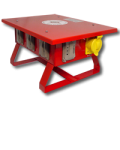cdcengineer
Senior Member
Hey all. I have always seen those spider boxes used for temp power. Usually the contractor runs 50 Amp, 4-wire as the feed for these boxes even though the receptacle configuration can vary on each box and the boxes usually have 50 Amp feed thru receptacles for powering additional spiders.
My question is, what type of load should we consider these spiders? The closest thing I can think of is NEC 551 using 9,600 VA for the 50 Amp feed. I am working on a project and they are installing receptacles to power temp spiders during events. This is a town project and they hold events throughout the year. No one really knows what loads the vendors will actually have, but they know that having spiders fed from generators in the past is what has worked.
Any feedback is greatly appreciated. Thanks.
My question is, what type of load should we consider these spiders? The closest thing I can think of is NEC 551 using 9,600 VA for the 50 Amp feed. I am working on a project and they are installing receptacles to power temp spiders during events. This is a town project and they hold events throughout the year. No one really knows what loads the vendors will actually have, but they know that having spiders fed from generators in the past is what has worked.
Any feedback is greatly appreciated. Thanks.



